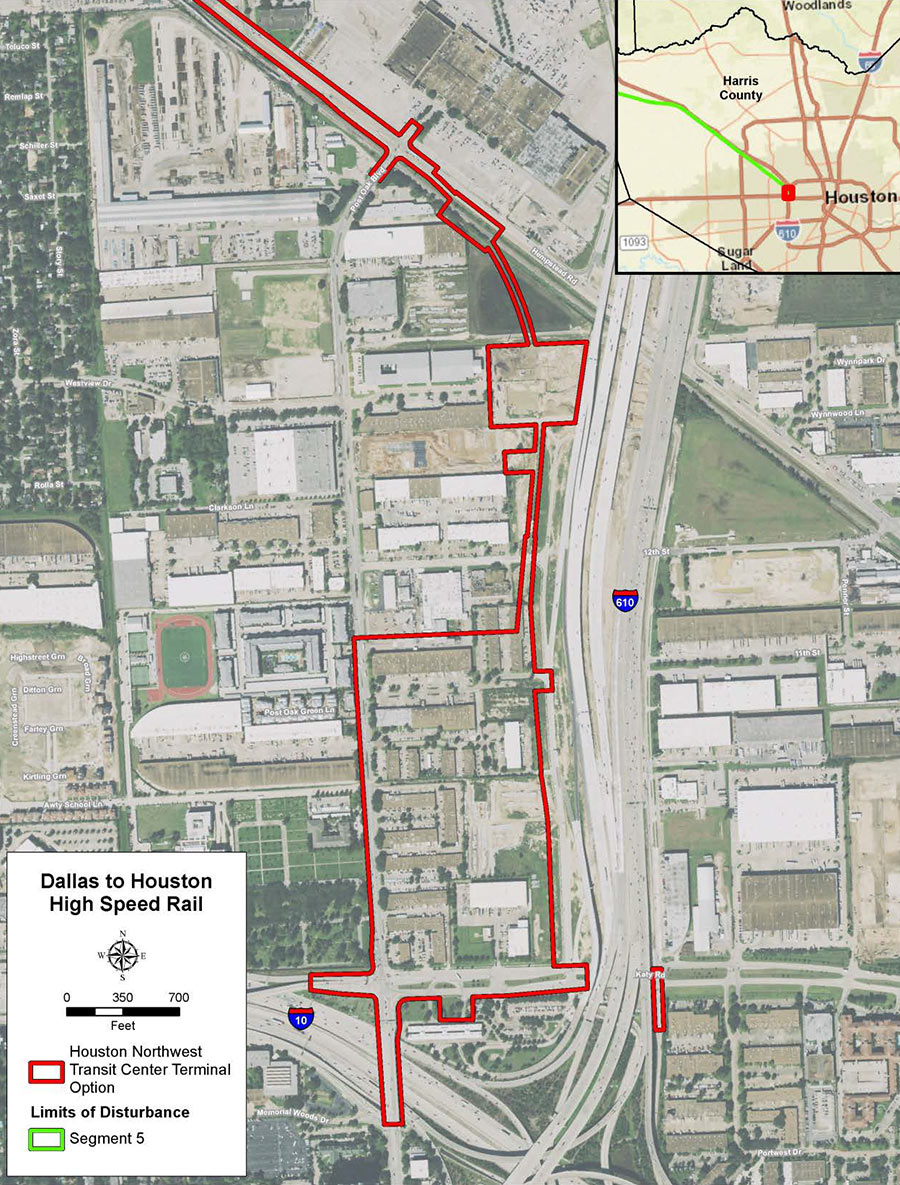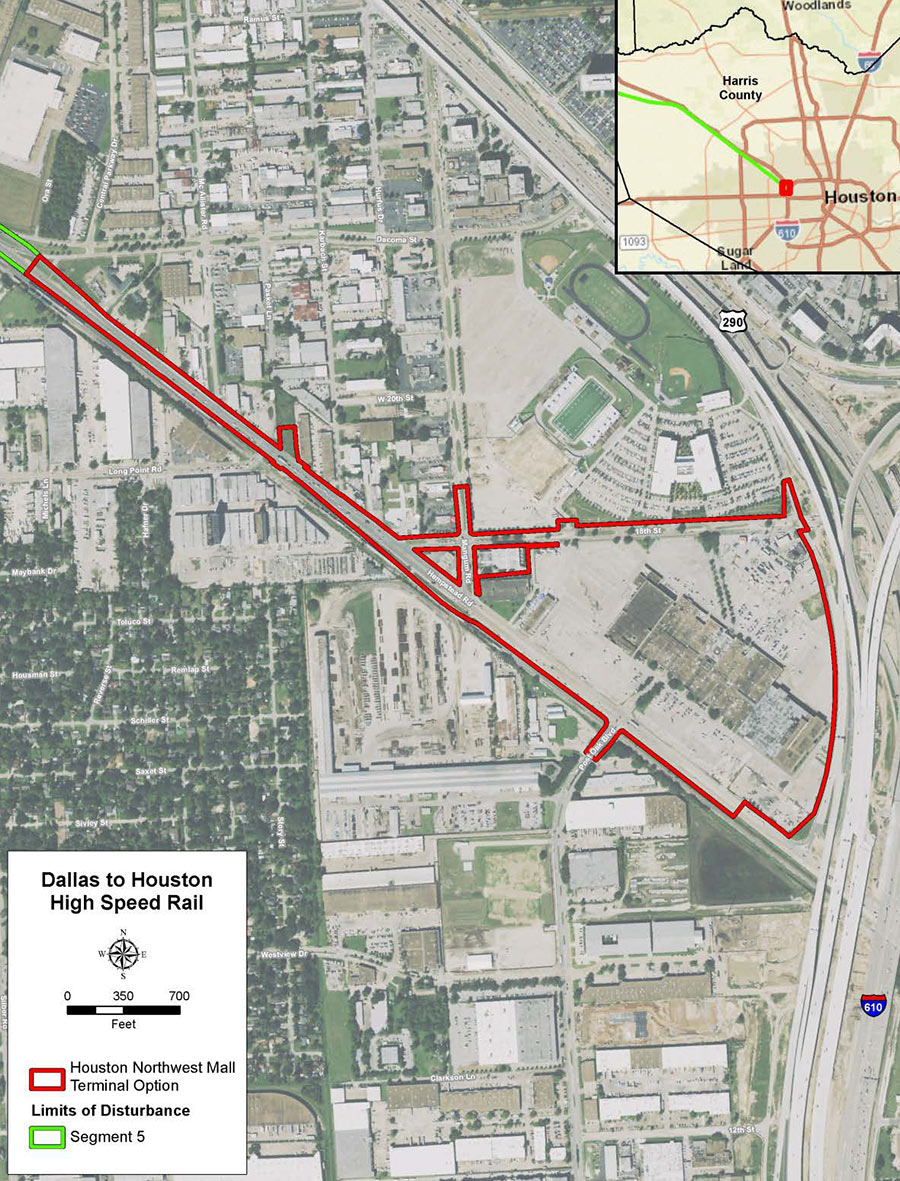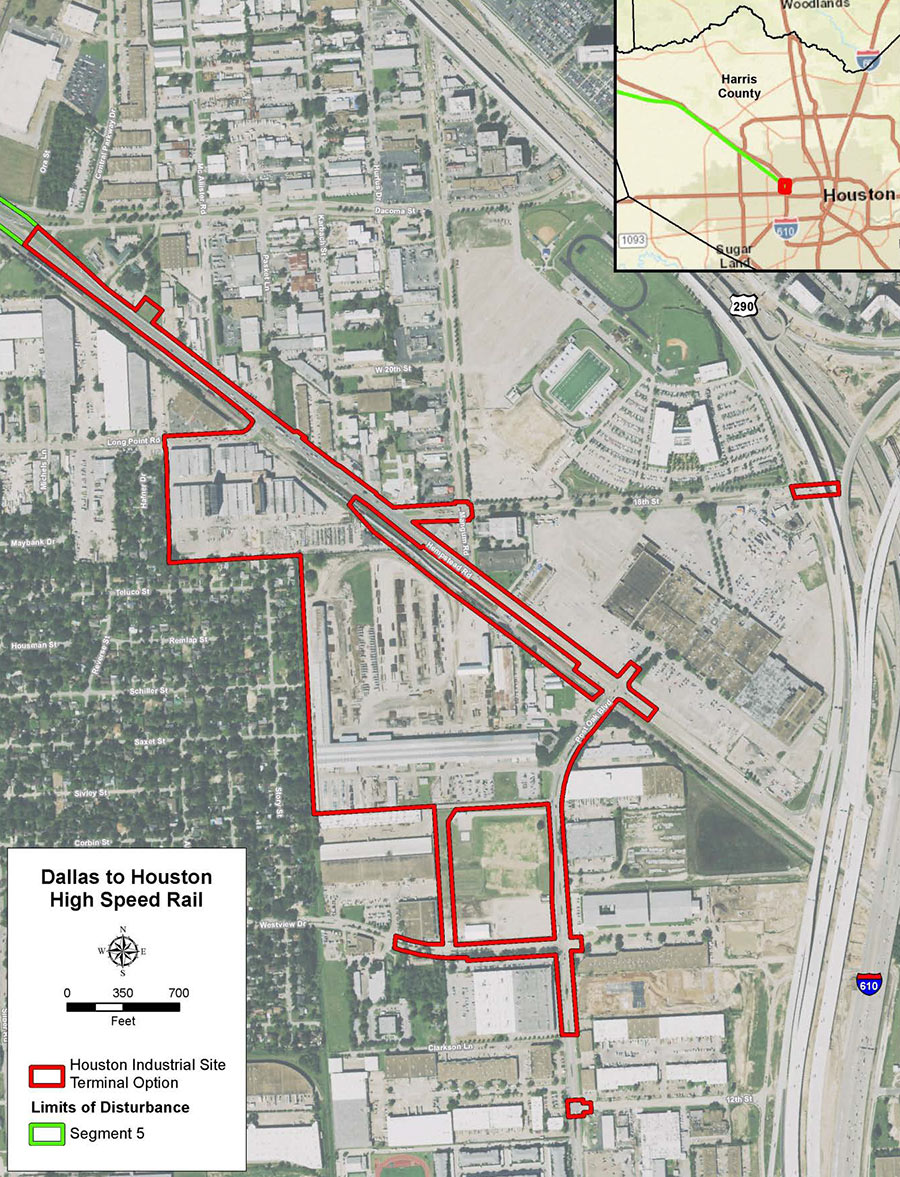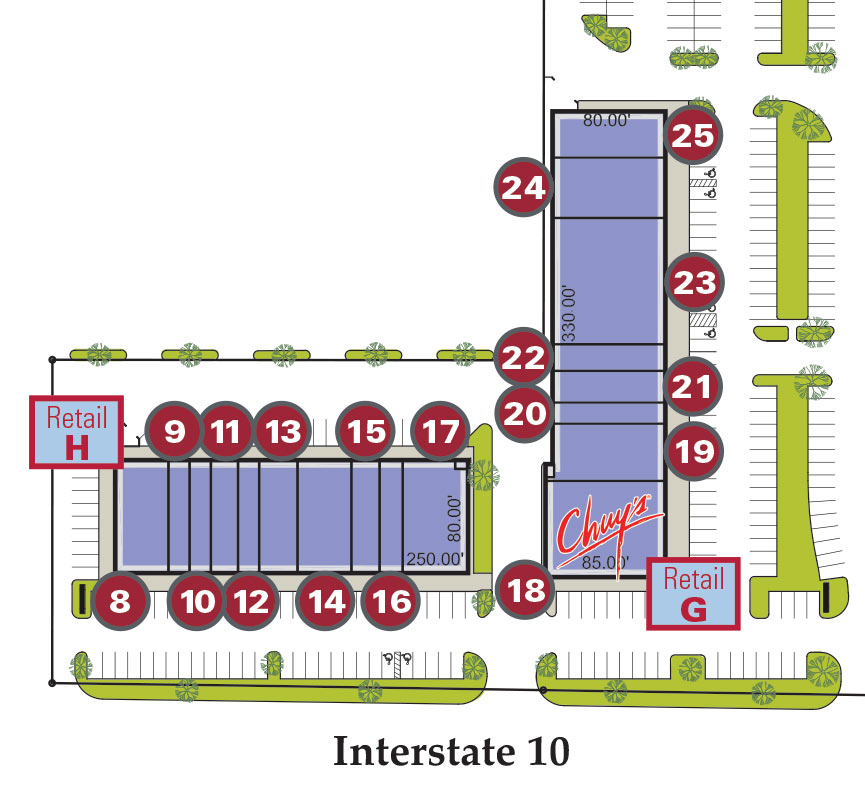
One of these 3 spots revealed in a report from the Federal Railroad Administration will be the planned site for the Houston-Dallas high-speed rail line’s Houston terminal. All 3 are near the intersection of the 610 Loop and the BNSF rail tracks that run parallel to Hempstead Rd. just south of 290.
In the map at top, the station takes the land directly north of the Northwest Transit Center, where an industrial complex home to Icon Electric, Engineering Consulting Services, and others exists now. Hempstead Rd. is shown fronting Northwest Mall at the top of the plan.
Another proposal puts the station in the spot where the mall is now:
***

A final map indicates the station across from the mall, on the southwest side of Hempstead:

Steel tube maker Tex-Tube occupies a spot within this proposed site right now. The plan shows the terminal extending across N. Post Oak Rd. and ending on the street’s east side.
The FRA’s report, which also lays out an entire proposed route between Houston and Dallas, took the agency 4 years to finish.
- Draft Environmental Impact Statement [Federal Railroad Administration via Christof Spieler]
- Houston-Dallas bullet train clears hurdle with environmental impact statement [Houston Chronicle]
- Previously on Swamplot:Â The Ride to the Bullet Train at Northwest Mall;Â Houston-to-Dallas Bullet Train Putting the Brakes on All Those Lawsuits;Â Houston-Dallas Bullet Train Shows Up on Trump Infrastructure Project List;Â Possible Station Locations for Houston-to-Dallas High-Speed Rail: Jersey Village, Mangum Manor, Downtown?
Images: Federal Railroad Administration





A better location would be in the Hardy Yards brownfields …
this area is ripe right now…
I was sort of waiting for an article about high-speed rail, since it’s all in the news today. Amtrak high-speed train on its inaugural trip derails, crashes onto the highway below, and kills multiple people and injures nearly a hundred more. Are we sure we want this thing?
90 minutes from Dallas to Houston, and then another 30 via Uber or a bus from NW Houston to the CBD. I’m still not a fan of the NW location.
The train should stop at NW Mall, which is dying anyway, where it can change to MetroRail (other 2 projected areas can still be utilized by city) then Metro can better control what happens from there. I’d trust Metro over the HSR contract workers, especially being from Dallas. Always remember, if Dallas really wants something, it’s probably not good for Houston. Which is why they initially wanted downtown Dallas to downtown Houston, which would not have hurt the south side of Dallas the way it would have hurt the north side of Houston. We had to fight to stop that ignorant idea. I had a twitter argument about it with an Arlington Rangers fan who only wanted HSR to downtown Houston so he could watch his Rangers easier, didn’t care one bit about the lives of people living in route on north side of Houston. He said that if he “has to switch to MetroRail on NW side of Houston then he won’t even use it!” Which is why we should be watching this whole project under a microscope, they do not care about the well being our city and never will.
@GoogleMaster – take a look at the VMS signs this time of year detailing the traffic deaths in Texas. Yes, I’d much rather a safer option
No matter which of the three sites is ultimately chosen, the area will look significantly different in 10-20 years time with all of the associated residential high-rises and office development that will surely follow.
GoogleMaster–the Shinkansen in Japan has never had an injury in 5+ decades of service.
AREJAY–What if your destination was Westchase, Uptown, the Energy Corridor, or The Woodlands? Why then would you want the station to be all the way Downtown? This is Houston, it’s about multiple nodes.
@AREJAY. I had the same thought with the NW location. I’m thinking there might be logistical issues involved with bringing high speed rail to any other quadrant of the city , especially if they are using existing ROW along freeways and utilities from Dallas. That 290-610 interchange is a disaster as it is, but perhaps it’s as close as they can get it without massive property buy outs and/or engineering a means to travel on a different level from street traffic. However, even with the 30 minute Uber, it would still beat the time it takes to get to the airport, go through security, delays, etc…
I’m still not convinced this thing is on the up and up. Do the powers that be have the path cleared with all of the property owners along the way? Do political donors own said property? I’m all for getting places more efficiently but I’d like to know that there isn’t a s**t load of influence peddling going on. I’m one of the “they” when you cats have great ideas about paying for stuff.
My impression is that both the proposed Houston and Dallas terminuses (termini?) are a terrible compromise versus the ideal.
The ideal? For Houston, let’s have the terminus on the NE side of downtown, just south of Buffalo Bayou, with an intermediate stop (tunnels) at Bush Intercontinental. There are freight lines in place that can be used or followed (if there are ROW/lack of eminent domain issues) by building the line on a viaduct, with tunnels around IAH. There could also be an elevated rail/tunnel link further to Houston Hobby airport mostly along existing rail routes.
At the Dallas end – c’mon, at least get to Union Station/Convention Center – not even the extra mile! Then you’ll then have a direct link to the Trinity Railway Express which links up to Fort Worth. The TRE should then have a spur in to DFW airport. And while we’re in Dallas, divert the Orange and Green lines track, via a tunnel to serve Dallas Love Field between Inwood and Burbank.
See, where I’m going? Between Dallas and Houston, in addition to linking two major metropolises, you’d then have 4, yes four, big airports acting as ground hub/spoke connections to one another linked by high speed rail and some form of direct subway/metro.
Yes, I know the airlines won’t like it because they’ll instantly lose their Houston to Dallas traffic. But on the plus side they should be included as investors in the rail infrastructure and then feel good about their reduced carbon footprint on this route. SWA, last time I looked, operated 19, yes, nineteen flights each way per day between DAL and HOU). That’s about 3,000 seats each way, a major contribution to the success of a properly connected high speed rail route.
So how about it, Texas? Think big – you’re a big state!
I like the idea of being able to get away from Dallas faster. I’m not sure about the value of getting there quicker.
They – whatever prop owners disagree will get served with eminent domain papers. The lawyers are a cost of doing business, just a line on the spreadsheet. Sorry, that’s how it is. Transportation is important.
@thomas – I dont see a transit center being a benefit to added development in an area. People dont get off trains just to hand around the train hub area. They will uber to their destination rather than stay there.
Look at what just happened in Washington State and the many others around the Nation in the past decade. Is it really necessary to have a high speed railroad?
Given the three options, the NW Transit Center is the better site for transportation purposes. Anything that ties into METRO’s Park & Ride and BRT services and that eliminates the need for additional transfers will be complimentary to the Houston-Dallas service. It may also be better situated for the coming of self-driven taxis and jitneys. A bonus is that using eminent domain to tie together a lot of disparate little industrial parcels will bring about their fairly immediate redevelopment, but that the NW Mall site is already mostly contiguous. When it gets redeveloped, whoever does so can do it as part of a well-thought-out master plan.
This technology is dated. Hyperloop, Driverless Cars, etc will make this whole thing unnecessary. Hyperloop will be cheaper, faster, and will make this train financially unfeasible. You are talking about 16-20 billion dollars to build it. Money only possible through Federal RR loans, which taxpayers will be on the hook for. The Feds will of course allow private interests (Drayton McLane, big Texas families) to buy the thing out of bankruptcy, which is exactly what the “founders” of this ill advised project are counting on. If that does not happen, the Bank of Japan will own a 240 mile long transportation corridor through the middle of Texas. Years of disruption, the scarring of NW Houston forever, incredible harm to the environment that can never be compensated for by moving a few thousand people a year from cars to trains (The train’s electricity is generated by burning coal by the way, FYI, it has a large electrical consumption too). I like what the other poster said about what is good for Dallas is not good for Houston. The people behind this are extremely corrupt, and have no qualms about suing people, including WW II veterans to get the land. I say corrupt because they have paid off every major newspaper and politician in the country to support this boondoggle. They have PR firms and lobbyists up the wazoo. If it is so good, why do they need all of that? Maybe because using eminent domain to foist an obsolete and overpriced monopoly foreign train technology onto Texas is not popular? The urban weenies love high speed trains and density, but most are renters with no skin in the game. My bet is they will ride it once, and realize $200 a ticket plus a $30 Uber ride is not really that great of a deal especially now that the TSA will be operating on the trains.
9, I think there was a Simpsons episode about this exact thing. They used a monorail instead, but they had a c catchy song.
@ Cloud Nine: While I agree about your skepticism of the project’s financial feasibility (passenger trains and especially high-speed trains are insanely expensive to build, especially in the U.S. for some reason), you are incorrect about the primary competition for this mode. It is not driving (autonomous vehicles or not), it is flying. The only folks who would be drawn out of cars by HSR are those who specifically hate flying but who don’t particularly like the drive either. The fact that you have to transfer to an Uber or rental car or whatever when you arrive makes it no different than flying.
.
That said, if this actually gets built and can charge a fare competitive with United and SWA, I imagine it won’t be hurting for passenger demand. I’d certainly prefer it from a comfort and hassle standpoint, and for many folks living and/or working in central, west and southwest Houston, it’s more convenient to access. But even with ample demand, it’s still hard to envision it generating a satisfactory financial return given the astounding capital cost.
.
I do agree that the Hyperloop, if competitive on passenger fares, would render this thing (and most parallel airline flights) obsolete due to the travel time benefit.
@ Cloud Nine: There’s no telling whether Hyperloop would be cheaper or faster or how long we have to wait for it. I am rather deeply concerned about the engineering of pressure vessels (designed for external pressure) that are hundreds of miles in length. There are too many opportunities for catastrophic failure — and the cause could be something as benign as an engineering or fabrication error (the odds of which increase geometrically with the number of parts) or it could be a stray bullet from a hunter or it could be an act of terrorism) — and the velocities involved and the G forces involved with the impact of a vehicle at cruising speed with air at atmospheric pressure would be totally fatal to all passengers. To make this work and make it safe and make it go in a straight line precisely to and from the points on a map that we would like to access, really the only option is Elon Musk’s other other company, The Boring Co. That company lists as a goal (not a social contract) that it should reduce the cost of tunneling from $1 billion per mile to $100 million per mile. Right away though, just for tunnel and nothing else, we’re looking at something like a $24 billion expenditure if they can deliver what they’re promising. I don’t think that we should bank on that. I’m actually quite content to bank on *any damn thing that gets built in Texas that costs billions of dollars or private investment*. Honestly, if this thing is obsolete in 10 years and the investors lose all their money, that’s fine. And if Hyperloop doesn’t pan out and HSR service turns out to be worthwhile, well okay then, better to have it than not, and better to have it sooner.
.
Furthermore, any federal money that can be diverted to Texas should be welcomed. Texas does not get its fair share of federal outlays. And that money is earmarked for something; the only sure way to lose at this game is not to play it.
.
Now if the project does declare bankruptcy and the Bank of Japan is the most senior debtholder, okay that’s fine. Bankruptcy only means that the bank takes a haircut. That doesn’t hurt Texans. And that haircut, by the way, is going to factor in outlays by the railroad for property taxes. And if a bunch of rich Texans step up at that point to buy TCR without a crippling burden of debt, well yeah what is wrong with that if you’re from here? That might actually be a good investment.
.
You speak of the scarring of NW Houston forever, irreparable harm to the environment, and years of disruption. Have you ever been to NW Houston? Come on now, *that* is a train that has left the station.
.
You mention that the train’s electricity would be generated by burning coal. Well yeah, obviously. Unless some project is generating its own electricity using proprietary generation, it doesn’t matter who you pay as your retail electricity provider because nobody gets to choose which of their electrons on the grid come from which power station. That’s not how it works. FWIW, no new coal plants are being planned and lots of coal capacity is slated for retirement.
.
Yes, they have no qualms about obtaining the land they need. They are a railroad company. This was settled in the legislature. They have powers of eminent domain. This entails lawsuits. Nothing about that paints a pretty picture, but that’s how the sausage is made. It does not paint a picture of corruption. Allegations of conspiracy or of widespread bribery and corruption need to be supported with evidence. The more widespread it is, the easier that should be to obtain…but I hear crickets chirping.
.
Will they take land from WWII vets? Yeah, sure. What, are WWII vets a protected class of persons? Land is land. I am not saying that that’s a pretty process for any human being, but that’s how the sausage is made.
.
You mention that the train will be overpriced. You don’t know that. You mention that the tech is foreign; but as long as it promises to obey American laws of physics, I’m okay with that. Are you concerned that the engineers might be relegated to the metric system? You say that it will be a monopoly. Sir or ma’am, do you know what a monopoly is? You are an idiot grasping at the straws of populist buzzwords. You speak of renters supporting it with no skin in the game; well, about that, understand that deeds, mortgages, and leases are all just financial instruments, the ends being possession and use of real property. Papers do not a virtuous man make, but everybody has skin in the game where the value of real property is concerned.
.
Your bet about ticket pricing being too high for most people ignores a matter of fundamental import. It shall be priced at the level that the market will bear. That means that the service will get used. TCR will not and cannot tolerate zipping a bunch of empty trains back and forth. It’ll be fundamentally different from the problems with SH 130 in Austin, where the road didn’t go where most people wanted to go, because this is a convenient Houston-Dallas connection. It has utility. It may very well go bankrupt, but it will do providing a service that reflects profit maximizing (or loss minimizing) equilibrium pricing. Those railcars won’t be empty.
.
To circle back to the point you made first, the advent of self-driving taxis and jitneys will no doubt be complimentary to transportation like high-speed inter-city rail as well as air travel. I have no doubt that it will afford people an opportunity to share a jitney and get from Houston to Dallas at very low costs, and indeed Coach USA already achieves that by operating large vehicles. Indeed, cheapskates will benefit too. I think that we need to recognize that there will be a lot of induced demand for inter-city travel in general as a consequence of this technology and that there will be a lot of people that aren’t willing to pay bottom dollar to make that journey in four hours at posted speed limits with group bathroom breaks at truck stops.
.
Now let me just say this about the anti-TCR crowd. There are legitimate ways to argue against TCR. I myself will not be investing money in them. You could try to make the case that they could not generate enough revenue to cover their operating expenses at any price, but *nobody is doing that*. The approach you actually are taking on this seems to vacillate between ignorance and intellectually dishonesty. I have no respect for it.
Look at the investors, they’re mostly Japanese and Chinese with a few token and probably bought off American politicians thrown in. This high speed rail is not needed, cannot make a profit and will end up being subsidized by the taxpayers like AMTRAK. But you had better believe the investors will make their money by milking taxpayers. Then it is doubtful it can be built in the first place. As a private railroad they cannot use eminent domain to seize the land needed for the right of way and county commissioners in several counties that will be negatively affected are refusing to allow it to cross county roads.